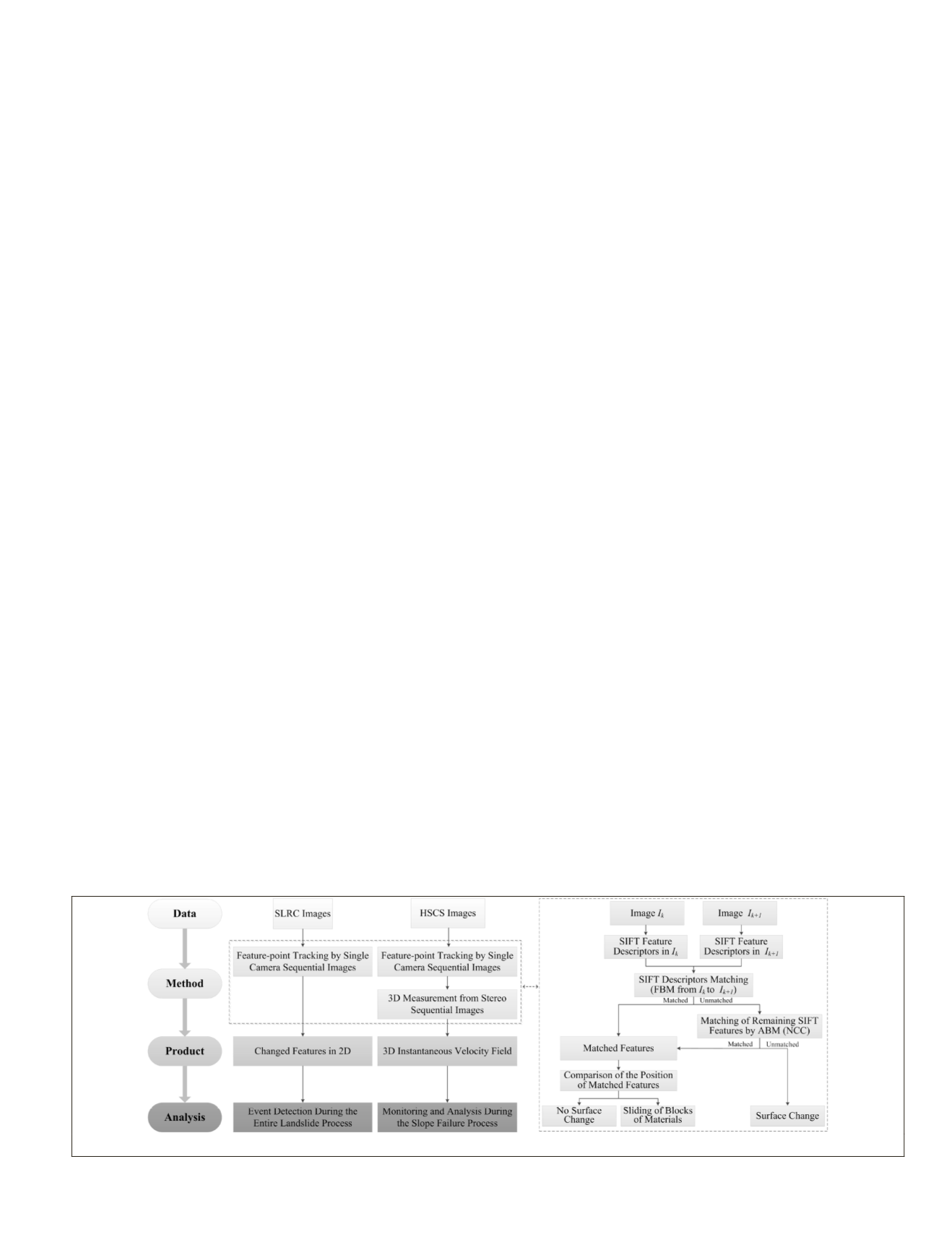
few seconds) but using a relatively long focal lens (35 mm)
to record the landslide body in greater detail. To obtain high
temporal resolution for the final slope-failure process, a high-
speed camera system (
HSCS
) comprising a pair of synchronized
DALSA Falcon 4M60 high-speed cameras (Teledyne, 2013)
captures images at a frequency of up to 62 Hz but using a
shorter focus lens (20 mm). The two cameras are synchronized
by a built-in synchronizer, and the synchronization accuracy
is 0.1 ms. Thirteen well-distributed marked points fixed on
the frame of the slope body are established as ground control
points (GCPs). Their coordinates are measured by a Sokkia
total station with an accuracy of ±1 mm. These
GCPs
are used
to reconstruct the orientation parameters of the cameras.
Dynamic Photogrammetric Processing of Single
and Stereo Image Sequences
Landslide surface changes are measured and analyzed using
two complementary techniques to consider the nature of the
deformation process (Figure 1- left): feature-point tracking
(
FPT
)
using single-camera sequential images and tracked 3D features
from successive stereo-image pairs. For both techniques, obtain-
ing a sufficient number of independently extracted features and
tracking them on the subsequent images are critical to the over-
all goal of deformation processing and monitoring. When the
slope surface changes at a slower pace, the
FPT
technique with
the single
SLRC
images is used to detect pre-failure events and
applied the start of higher frequency detection. Although also
supplied to the
FPT
for pre-failure event detection, the
HSCS
im-
ages are mainly employed to detect high-speed surface changes
during the slope collapse stage, in which the features are deter-
mined in 3D and tracked in the time domain. The tracked 3D
features are used to map the velocity field of the slope.
FPT for a Single-Image Sequence and Instability Detection
Sequential images obtained by a single camera are occasion-
ally the only data source for measuring landslide surface
displacements (Maas
et al
., 2013), such as when the environ-
ment or budgetary resources do not permit the installation
of multiple cameras. In this subsection, a sequential image
analysis approach based on FPT is applied to consecutive im-
ages taken by
SLRC
.
The box in Figure 1-right shows the detailed workflow
of the proposed FPT algorithm; this workflow is crucial for
producing reliable results. This algorithm is based on the
ability to track the same features in two consecutive im-
ages if the slope surface change is insignificant or if the time
interval between the two images is so short that the change
reflected in the images is insignificant. Otherwise, significant
surface changes in the landslide model can be divided into
two categories. In the first category, a block of materials may,
for example, slide with its layers at different depths moving
at the same speed (or different speeds); the surface features of
the block can be tracked in two consecutive images, and the
velocity of the tracked surface features can thus be estimated.
The other category includes partial collapses of materials in
which no corresponding features can be tracked; in this case,
it is important to note that a significant non-rigid body defor-
mation should have occurred in this area.
Different feature-extraction algorithms have been tested in
preliminary stages. The scale-invariant feature transform (
SIFT
)
published by Lowe (2004) is the most effective method for our
study because it can provide initial features in high density
over the entire slope surface (Feng
et al
., 2012). Features ex-
tracted in two consecutive images by the
SIFT
operator for the
same objects may exhibit different descriptive characteristics
due to the effects of imaging conditions (e.g., wind, sunlight,
and shadows). Therefore, both the feature-based matching
(
FBM
) strategy and the area-based matching (
ABM
) strategy are
integrated in the proposed
FPT
algorithm to identify corre-
sponding features in the consecutive images. In Figure 1, the
FBM
approach is applied to compare the
SIFT
descriptors of
the extracted features in the consecutive Images
I
k
and
I
k+1
.
Depending on whether the extracted features are matched in
the two consecutive images, different outcomes are expected:
• If the
SIFT
features are successfully matched, either
an absence of surface changes or the sliding of some
blocks of materials should have occurred during the
time interval. These two situations can be further dis-
tinguished by comparing the positions of the matched
features in Images
I
k
and
I
k+1
, respectively.
• In the case of unmatched
SIFT
features, a second at-
tempt is made to identify the corresponding feature for
I
k
in
I
k+1
using the
ABM
approach (the same attempt for
unmatched features in
I
k+1
is also made). If the corre-
sponding feature is not identified, the surface should
have changed; otherwise, there is a pair of matched
features, and their positions are compared in the same
way as in the
SIFT
features are successfully matched.
The
ABM
approach is implemented using a normalized cross-
correlation (
NCC
) between two image windows, one centered at
the feature in
I
k
and the other moving around in
I
k
+1
. If a feature
to be matched in
I
k
is located in the area of a sliding block, the
search area of this feature in
I
k+1
will be predicted by an affine
transformation model using the matched features in its sur-
roundings. A threshold for the correlation coefficient (
ρ
≥
0.8)
was selected based on the results of a few preliminary tests.
After the proposed
FPT
algorithm is performed for each
consecutive image pair, three types of outcomes can be
achieved: unchanged features, sliding block features, and
changed features. On one hand, we used the percentage of
Figure 1. Overall strategy for photogrammetric processing of SLRC and HSCS images captured for monitoring landslide surface changes.
PHOTOGRAMMETRIC ENGINEERING & REMOTE SENSING
July 2016
549


